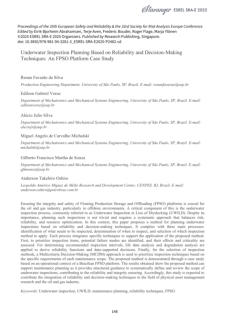Non Destructive Testing (NDT) 2024 - 2025







Click on the
octopus to return to
the top of the page

Authors: Zehao Wang, Defeng Zheng, Xingsen Guo,
Zhongde Gu, Yueqiang Shen, & Tingkai Nian
This study explains the impact of submarine landslides on
underwater structures, focusing on bucket foundations. It
introduces a fluid-structure coupling system using the
coupled Smoothed Particle Hydrodynamics (SPH)-Finite
Element Method (FEM) to analyze the displacement
response of these foundations during landslide impacts.
The research aims to provide a new numerical simulation
approach and offers insights into underwater structures'
dynamic response and failure mechanisms under extreme
conditions.

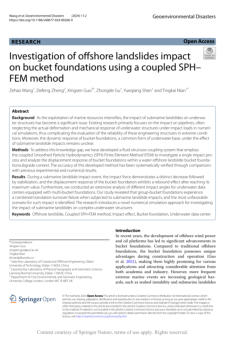

Authors: Hao Wang, Kan Wang, Xiaolei Liu, Yang Liu,
Zhijia Qian, and Sheng Ding
This study explains the development and analysis of an
offshore floating photovoltaics (FPV)-based hydrogen
production system. It addresses the challenges, particularly
safety concerns, associated with hydrogen storage in such
systems. It involves creating a numerical 3D model to
investigate the characteristics of accidental damage and
hydrogen release under different offshore wind
conditions. It also explores the dynamic development of
hydrogen dispersion and evaluates the evolution of
thermal hazards and damage in the marine environment.

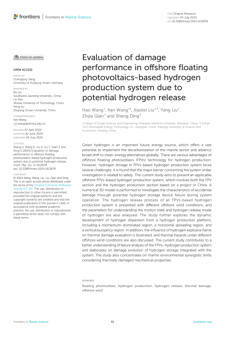

Authors: Oleg Gaidai, Yu Cao, Yan Zhu, Fuxi Zhang, and
Hongchen Li
A new reliability method suitable for multi-dimensional
structural dynamics is introduced in this study, using the
Gaidai multivariate method on an offshore Jacket
platform in Bohai Bay. It estimates collapse risks under
environmental stress, addressing challenges of high
dimensionality and nonlinear correlations. This method is
essential for offshore engineers during design to assess
operational failure, damage, or hazards.


04 - Multivariate Risk Assessment for Offshore Jacket Platformsby
Gaidai Reliability Method.
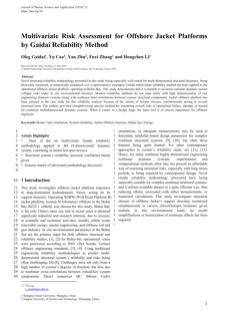
Authors: Jingzhou Xin, Guangjiong Tao, Qizhi Tang, Fei
Zou, Chenglong Xiang
This study proposes a new damage identification method
using Swin Transformer and continuous wavelet
transform (CWT). It converts structural vibration data into
a time-frequency diagram to capture damage
characteristics. The Swin Transformer extracts damage
information from this diagram. The method's accuracy is
analyzed with various sample lengths and noise levels,
confirming its robustness. Laboratory tests show it
recognizes damage with 99. 6% accuracy for single
damage and 99. 0% for multiple damages.


07 - Structural damage identification method based on Swin
Transformer and continuous wavelet transform.
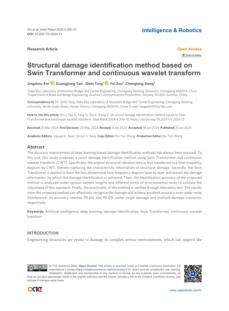

Authors: Andrei Nazarov, Tatiana Yurasova, and Andrey
Marshakov
This review examines how different aqueous electrolytes
impact hydrogen absorption and self-corrosion in
magnesium anodes. It discusses historical and recent
studies on mechanisms of self-corrosion and hydrogen
evolution under specific effects. The focus is on
magnesium hydride formation and oxidation during
active dissolution and how anodic dissolution occurs
through protective films in other conditions. It also looks
at factors influencing hydride formation and self-
corrosion.

14 - Hydrogen Absorption and Self-Corrosion of Mg Anode:
Influence of Aqueous Electrolyte Species
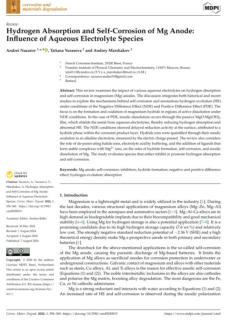

Authors: Yuheng Chen, Haicheng Zhang, Weisheng
Zou, Haihua Zhang, Bin Zhou, Daolin Xu
This study proposes a new ROV-based deep-sea mining
system to address slippage and sinking issues of
traditional vehicles. A learning-based control strategy is
introduced, utilizing a nonparametric learning method to
improve path-tracking performance.


16 - Dynamic modeling and learning based path tracking control
for ROV-based deep-sea mining vehicle.
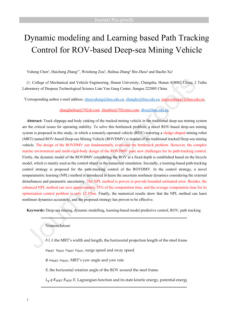

Authors: Beate Oswald-Tranta
Inductive thermography is a strong inspection method for
finding defects in metals. The technique has improved
over decades from lab tests to industry use. This paper
reviews its theory and key technical aspects. While it can
find various defects, the focus is on detecting surface
cracks in metals, with examples of current industrial
applications.


19 - Inductive thermography – review of a non-destructive
inspection technique for surface crack detection
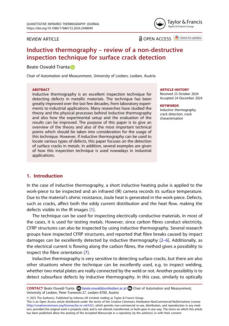

Authors: Mohammadebrahim Bajgholi, Gilles Rousseau,
Denis Thibault, Simon Francoeur.
This study evaluates advanced Non-Destructive Testing
(NDT) techniques for detecting flaws in welded repairs of
martensitic stainless steel plates, focusing on Francis
turbine runners. Phased Array Ultrasonic Testing (PAUT),
Total Focusing Method (TFM), and Eddy Current Array
(ECA) technologies were examined to assess repair
integrity and identify flaws such as lack of fusion (LOF).
The findings highlight the necessity of integrating
advanced NDT techniques to ensure the structural
integrity of critical components, particularly in high-stress
applications such as turbine runners.


23 - Advanced Non-Destructive Testing Techniques for Welded
Joint Repairs: A Case Study on Improving Inspection Reliability
and Structural Integrity Assessment
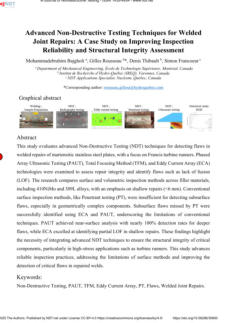

Authors: Luca Paterlini, Andrea Marinelli, Andrea Brenna
and Marco Ormellese
This document proposes a risk map to manage
phenomena linked to the fact that carbon steel structures
that transport hydrocarbons have systems to prevent
corrosion, including cathodic protection and insulating
coatings, and that electrical interference, both AC and DC,
can cause corrosion even with protection applied.


24 - Protection Criteria of Cathodically Protected Pipelines Under AC
Interference.
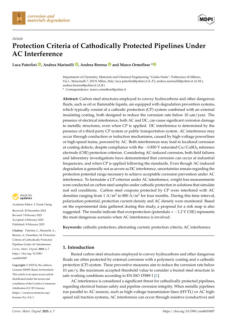



25 - Natural van der Waals canalization lens for non-destructive
nanoelectronic circuit imaging and inspection
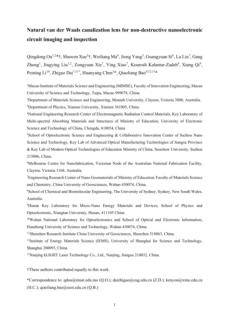
Authors: Qingdong Ou, Shuwen Xue, Weiliang Ma,
Jiong Yang, Guangyuan Si , Lu Liu, Gang
Zhong, Jingying Liu, Zongyuan Xie, Ying Xiao,
Kourosh Kalantar-Zadeh, Xiang Qi, Peining Li,
Zhigao Dai, Huanyang Chen, Qiaoliang Bao
Optical inspection is important in semiconductor wafer
manufacturing for analyzing surfaces and defects.
Traditional methods struggle with resolution and
detecting buried structures. The authors suggest a new
approach using a van der Waals canalization lens from a-
MoO 3 crystals, achieving 15 nm resolution for both
surface and buried imaging. This method offers better
imaging without the issues faced by other lenses,
enabling high-resolution inspection of buried nanoscale
circuits, crucial for future semiconductor manufacturing.

Authors: Andrzej Katunin, Krzysztof Dragan, Marko
Nagode, Krzysztof Lis, Kamil Joszko, Adam
Cholewa, Jernej Klemenc, Simon Oman, Paweł
Zak, Piotr Synaszko
Hidden corrosion, if not found quickly, can greatly
impact the strength and safety of aircraft. Enhancing
non-destructive testing (NDT) methods is crucial for safe
aircraft operation. The D-Sight technique is commonly
used for detecting this corrosion, valued in the
aerospace industry for its fast and low-cost inspections.
One of the drawbacks


26 - Towards quantification of hidden corrosion using D-Sight non
destructive testing technique
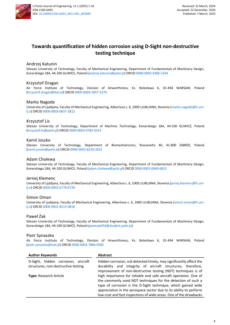

Authors:
Emmanuella Onyinye Nwulu, Tari Yvonne Elete,
Friday Emmanuel Adikwu, and Fidelis Othuke Onyeke
The durability of coatings is crucial for protecting
infrastructure from damage. This study suggests a
framework using advanced non-destructive testing
(NDT) technologies for inspecting coating durability. It
incorporates methods like ultrasonic testing and data
analytics to find defects and predict lifespan. Case studies
show this approach improves decision-making and saves
costs. The framework promotes better inspection
practices across different sectors for enhanced
performance and sustainability.


20 - Advancing inspection techniques for coating durability: A
framework for integrating non-destructive testing technologies.
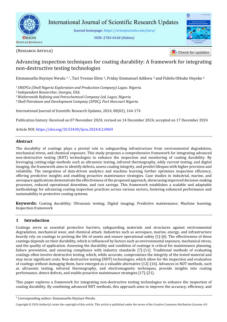
Authors: Jun Ito, Yudai Igarashi, Ryota Odagiri, Shigetaka
Suzuki, Hiroshi Wagatsuma, Kazuhiro Sugiyama,
and Mikihiko Oogane
The magnetic hammer test (MHT) is a nondestructive
inspection method that uses a tunnel magnetoresistance
(TMR) sensor to detect weak magnetic fields generated by
natural pipe vibration. The method can accurately
evaluate wall thickness with tens of microns and
underwater with less than 100 µm accuracy. This
noncontact, fast, and accurate method contributes to
unmanned, manpower-saving nondestructive testing
(NDT) in the future.


02 - Evaluation of Pipe Thickness by Magnetic Hammer Test with a
Tunnel Magnetoresistive Sensor
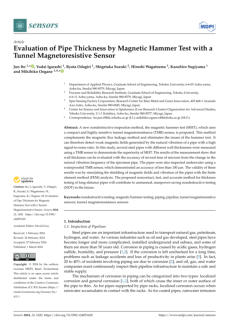
Authors: Jianghai He
This essay discusses the practical application of remote-
operated underwater vehicles for inspecting dams and
bridges, addressing safety issues like leakage, erosion, and
cracks. It highlights the advantages of these vehicles
compared to traditional divers, their operation in low-
visibility water, stabilizing positions in turbulence, and
overcoming cable entanglement issues. The paper also
provides an outlook for their development in underwater
detection and reinforcement to address future
maintenance challenges.


03 - Introduction Remote-operated Underwater Vehicle for
Inspection of Underwater Structure
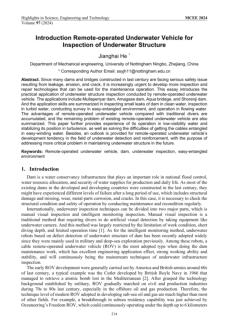
Authors: Manuela Ammann
Switzerland's hydropower plants are the primary source of
renewable energy, accounting for 57% of electricity
production. However, high maintenance costs and
manual inspections are costly. A workflow for underwater
photogrammetry using Remotely Operated Vehicles
(ROV) has been developed, enabling accurate 3D
reconstruction of underwater objects. The system provides
sub-centimere accuracy at object distances.


05 - Robotic photogrammetric underwater inspection of
hydropower plants
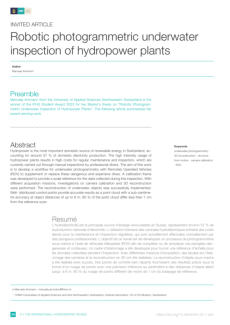

Author: Ayush Kumar Ojha
This study explores the use of deep learning methods for
processing and interpreting underwater images and
videos. The suggested methods, utilizing convolutional
neural networks and generative adversarial networks
(GANs), improve image quality, identify marine species,
and detect anomalies for infrastructure inspection. The
findings highlight the transformative potential of artificial
intelligence in overcoming the limitations of traditional
underwater image processing techniques, paving the
way for more effective and efficient underwater
exploration and conservation efforts.


06 - Deep Learning Techniques for Enhanced Underwater Remote
Sensing: Applications in Marine Biodiversity and Infrastructure
Inspection
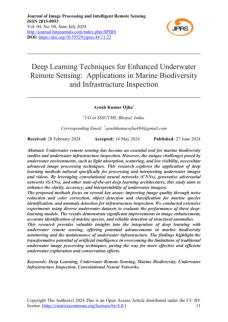
Authors: Yifan Tian, Alexander Grigorievich Palaev, Ildar
Ayratovich Shammazov and Yiqiang Ren
This study proposes a non-destructive testing technology
for pipeline corrosion based on electromagnetic
ultrasound technology to improve stability and safety in
energy pipeline transportation systems. This technology
uses empirical mode decomposition and singular
spectrum analysis to denoise electromagnetic ultrasound
signals, removing mild noise pollution and accurately
detecting small area defects, thereby aiding in the regular
maintenance of pipeline energy transmission systems.


08 - Non-destructive testing technology for corrosion wall thickness
reduction defects in pipelines based on electromagnetic
ultrasound
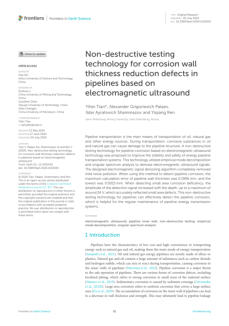
Authors: M. Mwelango, X. Yin, M. Zhao, Z. Zhang, Z.
Han, R. Fan, P. Ma, X. Yuan, and W. Li
This paper explores the use of coplanar capacitive sensors
for underwater structural integrity assessment. It compares
the performance of bare-electrode and insulated-
electrode sensors, revealing that electrical conductivity
significantly influences response. The study also highlights
the feasibility of defect detection, characterisation, and
imaging under water, highlighting the potential of
underwater NDE techniques for inspecting structures and
equipment in underwater environments. This research
broadens underwater NDE knowledge.


09 - Feasibility Study on the Use of the Coplanar Capacitive Sensing
Technique for Underwater Non-Destructive Evaluation
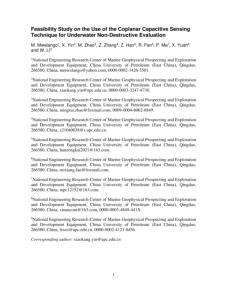

Authors: Siqiang Cheng, Yi Liu, Aibin Tang, Libin Yang
This document introduces an underwater robot
inspection anomaly localization feedback system, which
uses real-time water surface tracking, detection, and
positioning. The system is housed within the underwater
robot, enabling the system to issue mechanical responses
based on the water surface's tracking and positioning.
The system uses sonar technology to monitor the
underwater robot in real-time, triggering responsive
actions upon anomalies. This system identifies abnormal
conditions and informs personnel for intervention.


11 - An Underwater Robot Inspection Anomaly Localization
Feedback System Based on Sonar Technology
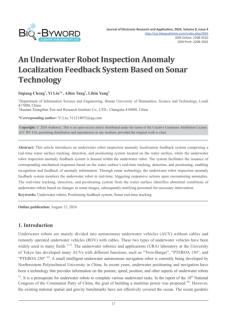

Authors:
Lutz Bretschneider, Sven Bollmann, Deborah Houssin-
Agbomson, Jacob Shaw, Neil Howes, Linh Nguyen, Rod
Robinson, Jon Helmore, Michael Lichtenstern, Javis
Nwaboh, Andrea Pogany, Volker Ebert, and Astrid
Lampert
The application of drone technology to pipeline leak
detection is examined in this article. It covers
environmental conditions, appropriate commercial
sensors, routine pipeline monitoring, and contemporary
uses of natural gas pipeline surveys. Additionally, the study
presents a feasibility assessment conducted during a
release experiment, emphasizing the minute-by-minute
change of wind direction. Requirements for future
applications are also produced.


12 - Concepts for drone based pipeline leak detection

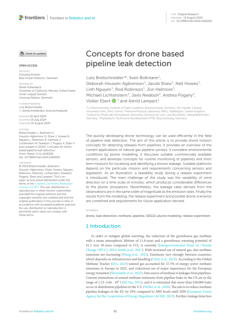

Authors: Ruben Rodríguez Elizalde
This study presents a novel underwater drone model for
examining submerged components of historic bridges.
Three bridges spanning various rivers were inspected
underwater as part of the study, which showed that
underwater drones are safer than existing techniques and
useful for this kind of assessment. Additionally, the drones
enable the investigation of characteristics like pier or
butment rotation or settlement that can forecast future
foundation issues that will impact the entire bridge.


13 - Underwater Inspection of Submerged Elements in Masonry
Bridges and Other Old Civil Structures Using Drones
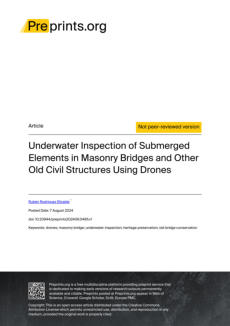

Authors: Valery Bobkov and Alexey Kudryashov.
The development of unmanned underwater vehicles
(AUVs) is crucial for inspecting industrial subsea structures,
but GPS is impractical due to underwater environment
interferences. Optical image processing offers higher
accuracy for AUV navigation. This study proposes a
technology to recognize underwater objects and provide
coordinate references to AUVs using stereo-image
processing. It uses a non-standard technique to generate
a geometric model of an object, uses characteristic
geometric elements, and compares visual data with an a
priori model.


15 - A Method for Recognition and Coordinate Reference of
Autonomous Underwater Vehicles to Inspected Objects of
Industrial Subsea Structures Using Stereo Images.
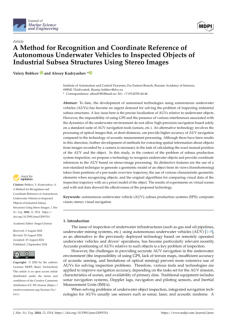

Authors: Seda Karadeniz Kartal, and Recep Fatih Cantekin
This study emphasizes the importance of using
unmanned underwater vehicles (UUVs) for pipeline
monitoring based on an experiment with a remote-
controlled UUV to detect pipeline damage. It mentions
that the UUV autonomously tracked the pipeline and
identified damages through camera images processed by
a convolutional neural network (CNN), achieving high
detection accuracy. It also mentions that the UUV
followed the pipeline precisely, with minimal navigation
errors.


17 - Autonomous Underwater Pipe Damage Detection Positioning
and Pipe Line Tracking Experiment with Unmanned
Underwater Vehicle
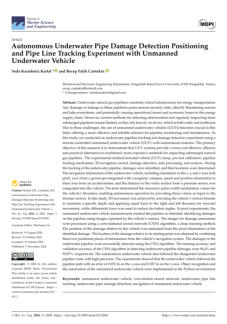



18 - Experimental Activity with a Rover for Underwater Inspection
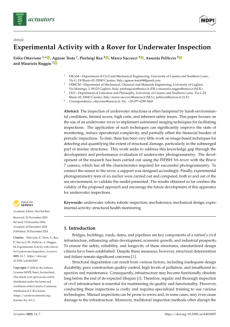
Authors: Erika Ottaviano, Agnese Testa, Pierluigi Rea,
Marco Saccucci, Assunta Pelliccio, and Maurizio
Ruggiu
This paper discusses the use of an underwater rover to
implement automated imaging techniques for
underwater structure inspections. The research aims to
improve monitoring, reduce operational complexity, and
offset the financial burden of periodic inspections. The
research uses the FIFISH V6 rover with a Brave 7 camera
and experimental photogrammetry tests of an anchor.
The results confirm the validity of the proposed approach
and encourage future development for underwater
inspections.
Authors: Yomi Femi, Ademola Romke
Smart pipeline monitoring systems, integrating advanced
technologies like sensors and AI, offer continuous,
proactive monitoring of pipeline systems. These systems
enable early detection of potential issues, enhance
operational efficiency, and minimize environmental risks.
They reduce downtime and repair costs, improve safety,
and offer predictive maintenance, transforming pipeline
infrastructure management in a sustainable and cost-
effective manner.


21 - Smart Pipeline Monitoring System: Revolutionizing Pipeline
Management
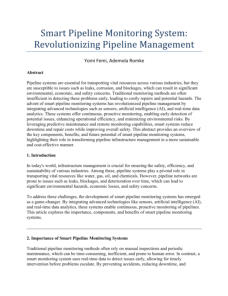

Authors: Maxime Fauconnier, Bhuvaneshwari
Karunakaran, Alex Drago-González, William S. Y.
Wong, Robin H. A. Ras, & Heikki J. Nieminen
This study introduces waves propagating on an
underwater superhydrophobic surface, allowing for the
stabilization of a microscale gas layer called a plastron. The
acoustic radiation force triggers kHz "plastronic waves"
with a high propagation speed of up to 45 times faster
than conventional deep water capillary waves. These
waves are useful for non-destructive monitoring of
plastron stability and spontaneous air diffusion in gas-
undersaturated or supersaturated water conditions.


22 - Fast capillary waves on an underwater superhydrophobic
surface
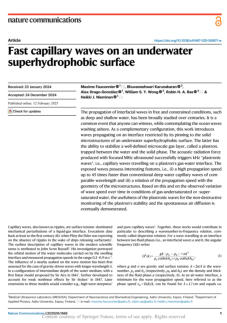

Authors: Qian Liu, Bin Xu, Xinhai Zhu, Ronglin Chen, and
Hanbin Ge
This study validated an interface debonding defect
detection and localization approach for scaled
underwater grouting jacket connections (GJCs) using
surface wave measurements with piezoelectric lead
zirconate titanate (PZT) actuation and sensing technology.
The approach was tested and showed that the mimicked
interface debonding defect was successfully detected, and
the region of debonding was determined by intersecting
abnormal wave propagation paths, providing a novel
non-destructive debonding defect detection method for
offshore wind turbine structures.


27 - Experimental Study on Interface Debonding Defect Detection
and Localization in Underwater Grouting Jacket Connections
with Surface Wave Measurements
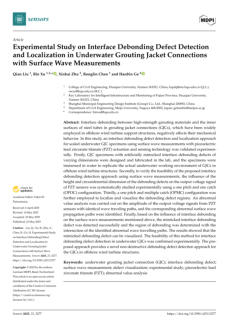

Authors: Xianfeng Zeng, Wenji Ai, Zongchao Liu, and
Xianling Wang
This paper introduces an unsupervised enhancement
framework for restoring underwater images with
structural cracks. It combines physical modeling of
underwater light transmission with a deep image
translation architecture. The approach includes a multi-
scale feature integration module and region-focused
discriminator. Validated on a real-world dataset, it shows
substantial improvements in visual quality and crack
boundaries preservation.


28 - Unsupervised Restoration of Underwater Structural Crack
Images via Physics-Constrained Image Translation and Multi-
Scale Feature Retention
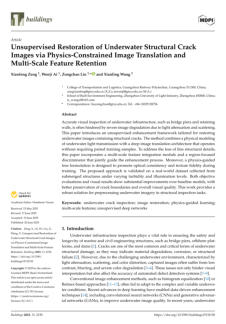

Authors: Renan Favarão da Silva, Edilson Gabriel Veruz,
Alécio Julio Silva, Miguel Angelo de Carvalho
Michalski, Gilberto Francisco Martha de Souza,
Anderson Takehiro Oshiro
This paper proposes a method for planning underwater
inspections based on reliability and decision-making
techniques. It identifies inspection needs, determines
when to inspect, and selects the appropriate method. The
method is demonstrated in a case study on a Brazilian
FPSO platform, supporting maintenance planning and
reliability.


29 - Underwater Inspection Planning Based on Reliability and
Decision-Making techniques: An FPSO Platform Case Study.
